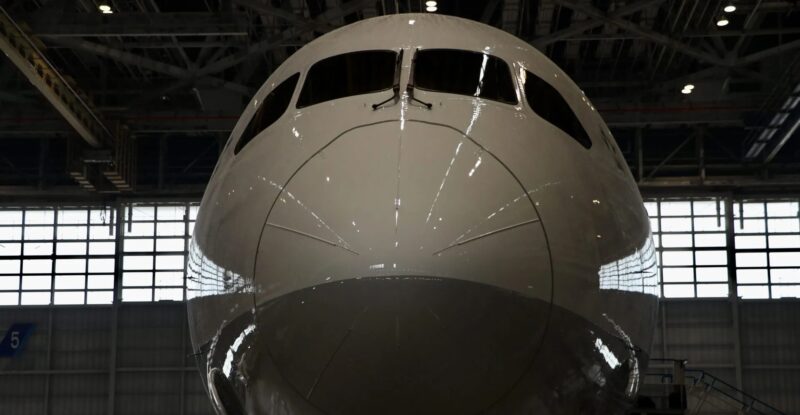UPDATE: Viasat clarifies that whilst it is pursuing a TSA with Boeing for linefit offerability of Aera, and work is afoot to meet the airframer’s requirements, it has not yet formalized an agreement.
Having committed to bring a dual-beam, multi-orbit electronically steerable antenna to market, Viasat is pursuing a technical services agreement (TSA) with Boeing to obtain linefit offerability for the Aera-branded kit as buyer furnished equipment (BFE).
“You just posted an article on the Boeing Aerodynamic Shroud. So, we’re basically designing it to fit into the Boeing footprint just for them,” says Don Buchman, vice president and general manager of Viasat’s Commercial Aviation Business, of Aera.
“We are in the TSA process with Boeing in ‘full flight’ on that. So, we’re working our STCs, in parallel to having the product on [the Boeing catalog], so having all that lined up with Telesat coming live, you know, at the end of 2027 into 28.”
After lengthy exploratory studies — Viasat has technically been working on phased array for up to 20 years — the firm in 2021 flight-tested a single-beam phased array antenna in collaboration with European Space Agency. This laid the groundwork for what comes next, the dual-beam Aera ESA that can simultaneously connect to both GEO and Telesat Lightspeed LEO satellites.
“We didn’t think ‘either or’ was a great solution. Our GM-40 [gimbaled antenna] could support that mission today, but that’s kind of a ‘here and now’ where you have to pick. But really what you want is the best of both worlds,” Buchman explains.
“What the capacity density does from GEO is it allows you to get the lowest unit economics from a cost perspective because the highest volume of data is what really drives your cost of delivering. And so, GEO is what allows us to do that in the most productive way. So, things like video and big downloads, you know, 80% of your data kind of comes that way. And then, the 10% to 15%, 20% that may be latency sensitive, you do that [via LEO]. And so, you wouldn’t want to make that an ‘either or’ decision, because you’re compromising one or the other. So, by doing a dual beam simultaneously you can actually match and have the terminal busy tracking both and sort of accomplish both things at the same time and deliver that savings.”
He adds: “Our hypothesis always has been that unit productivity costs of your bandwidth will be the number one thing: make sure I don’t run out, and make sure that what I’m producing is going to continually scale such that more and more bandwidth is consumed for the same kind of end price.”
One terminal, Category 4
Boeing says it’s able to slide two ESAs into the Boeing Aerodynamic Shroud. But that won’t be necessary for Aera as it’s a single “integrated terminal,” confirms Buchman. “When we say dual-beam, it’s not two apertures split: it could be all GEO; it could be all LEO; and it could be split between the two.”
Though dual-beam ESAs for commercial aviation continues to have their skeptics — with some arguing you don’t have to pack everything into one terminal, given airlines’ clear acceptance of two-antenna configurations for LEO satcom-only powered IFC – Viasat reckons that the planets are aligning for this type of technology.
Says Buchman:
The market had to be ready. You had to have the right GEO, the right LEO, and the right technology and the demand for the market, and so I think all those things have come together sort of in time. This is the moment now when you sort of hit the accelerator.
Viasat is not part of the Seamless Air Alliance, but does it see Aera as fitting into Seamless’ Type 4 category for aero antennas, i.e., a hybrid with the full breath of GEO coverage?
“That’s what we’ve been aiming towards is having it be basically one terminal that can do both. We always talked about how we’d like to have multi-beam, multi-orbit, and multi-band. So, let’s get two of three. The multi-band is [about] doing Ku and Ka at the same time; that’s a little bit of a bridge too far. It’s newer technology. But right now, this is Ka only, and I think that’s generally what everyone’s kind of doing on the market [in terms of dual-beam ESAs; one band or the other.]
In a statement celebrating Viasat’s Aera advances, European Space Agency says, “Commercial service for Viasat Aera is expected to begin in 2028. The terminal is designed for backward compatibility with existing onboard hardware, making it suitable for most aircraft using earlier-generation antennas.”
An Airbus update?
RGN and indeed other industry stakeholders had hoped Airbus would update the market in October about how its linefit, supplier-furnished HBCplus program is evolving, both for the Ku-band side of the program and in support of a potential multi-orbit, dual-band hybrid Ku/Ka architecture inclusive of a LEO-only ESA to facilitate Eutelsat OneWeb, Amazon Project Kuiper or possibly SpaceX Starlink.
Airbus tells RGN: “On our side, it is too early for an exchange on that subject and how it’s evolving. But we would be happy to brief you at a later stage, potentially in December.”
Though we have not received a briefing, we are hearing that Airbus is getting a little more flexible in terms of accommodating new architectures, and might even bend a little on the BFE catalogue (which it vowed not to update after announcing HBCplus).
Is Viasat hearing the same?
Speaking broadly, Buchman noted that Viasat’s airline customers advocated for the GM-40 terminal to be linefit offerable and are advocating now. Some airlines prefer to take delivery of new aircraft and install IFC systems post-delivery. Some prefer to have the system linefit (the GM-40 is linefit as BFE at Airbus, Boeing and Embraer). Some prefer the Service Bulletin approach.
“And so I think we’re seeing enthusiasm out of Boeing, and I think we’re hopeful that we’ll have the same enthusiasm, you know, in the market. If the market accepts this as a really good solution, you know, we’re hoping we’ll see the same enthusiasm,” he said of Aera offerability at Airbus.
Interestingly, ThinKom Solutions, which builds the Ka2517 VICTS antenna in support of the Safran Passenger Innovations terminal being used by Airbus for the Ka-band side of HBCplus, believes its ThinAir Plus mix-and-match VICTS + LEO-only ESA architecture will be made linefit offerable at Airbus, offering dual-beam functionality with two antennas sitting side-by-side. That would suit Hughes Network Systems, which is already offering a retrofit package with this architecture and has won Delta as a customer including for select new-delivery A321neos and A350-1000s, and possibly SES, which recently revealed to RGN that it’s exploring a similar approach now that it owns Intelsat, a distribution partner for Eutelsat OneWeb LEO in aero.
Related Articles:
- How Boeing Global Services is supporting Starlink installs on 787s
- Viasat nears launch of VS-3 F2 satellite aboard ULA Atlas V rocket
- SES looks to bolster Open Orbits for airlines
- Viasat details Amara nextgen inflight connectivity strategy
- Viasat HEO payloads to soon support airlines with legacy GX hardware
- ANA taps Viasat to power free Wi-Fi on international routes
- Seamless’ category systems for IFC antennas rates Airbus Type 4
Featured image credited to ANA












